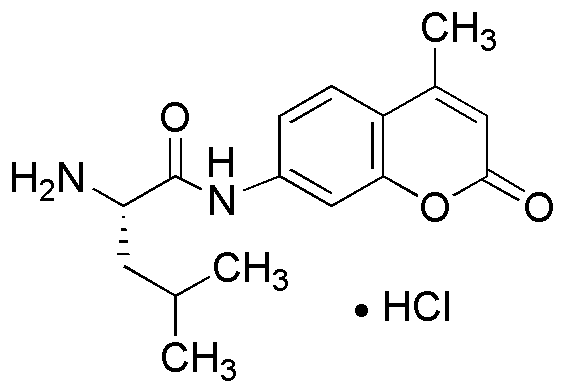L-Leucine 7-amido-4-methylcoumarin hydrochloride is widely utilized in research focused on:
- Biochemical Assays: This compound serves as a substrate in enzyme assays, allowing researchers to study enzyme kinetics and activity, particularly in protease research.
- Fluorescent Probes: Its unique structure makes it an effective fluorescent probe for tracking cellular processes in live cell imaging, enhancing visualization in biological studies.
- Drug Development: The compound is explored in pharmaceutical research for its potential role in developing new therapeutic agents, particularly in targeting metabolic disorders.
- Protein Synthesis Studies: It is used in studies related to protein synthesis, helping researchers understand the role of amino acids in cellular functions and metabolism.
- Analytical Chemistry: This chemical is applied in analytical methods for detecting and quantifying amino acids in various samples, providing valuable data for nutritional and clinical research.
General Information
Properties
Safety and Regulations
Applications
L-Leucine 7-amido-4-methylcoumarin hydrochloride is widely utilized in research focused on:
- Biochemical Assays: This compound serves as a substrate in enzyme assays, allowing researchers to study enzyme kinetics and activity, particularly in protease research.
- Fluorescent Probes: Its unique structure makes it an effective fluorescent probe for tracking cellular processes in live cell imaging, enhancing visualization in biological studies.
- Drug Development: The compound is explored in pharmaceutical research for its potential role in developing new therapeutic agents, particularly in targeting metabolic disorders.
- Protein Synthesis Studies: It is used in studies related to protein synthesis, helping researchers understand the role of amino acids in cellular functions and metabolism.
- Analytical Chemistry: This chemical is applied in analytical methods for detecting and quantifying amino acids in various samples, providing valuable data for nutritional and clinical research.
Documents
Safety Data Sheets (SDS)
The SDS provides comprehensive safety information on handling, storage, and disposal of the product.
Product Specification (PS)
The PS provides a comprehensive breakdown of the product’s properties, including chemical composition, physical state, purity, and storage requirements. It also details acceptable quality ranges and the product's intended applications.
Certificates of Analysis (COA)
Search for Certificates of Analysis (COA) by entering the products Lot Number. Lot and Batch Numbers can be found on a product’s label following the words ‘Lot’ or ‘Batch’.
Numéro de catalogue
Numéro de lot/série
Certificates Of Origin (COO)
This COO confirms the country where the product was manufactured, and also details the materials and components used in it and whether it is derived from natural, synthetic, or other specific sources. This certificate may be required for customs, trade, and regulatory compliance.
Numéro de catalogue
Numéro de lot/série
Safety Data Sheets (SDS)
The SDS provides comprehensive safety information on handling, storage, and disposal of the product.
DownloadProduct Specification (PS)
The PS provides a comprehensive breakdown of the product’s properties, including chemical composition, physical state, purity, and storage requirements. It also details acceptable quality ranges and the product's intended applications.
DownloadCertificates of Analysis (COA)
Search for Certificates of Analysis (COA) by entering the products Lot Number. Lot and Batch Numbers can be found on a product’s label following the words ‘Lot’ or ‘Batch’.
Numéro de catalogue
Numéro de lot/série
Certificates Of Origin (COO)
This COO confirms the country where the product was manufactured, and also details the materials and components used in it and whether it is derived from natural, synthetic, or other specific sources. This certificate may be required for customs, trade, and regulatory compliance.


